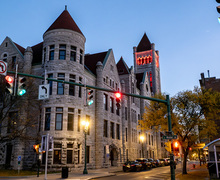JVP holds Tashlich ceremony, mourns Israel-Hamas war victims
Solange Jain | Asst. Photo Editor
Tashlich participants hold up a banner that reads, “Mourn the Dead. Fight for the Living.” The group reaffirmed its support for Palestine and ending the Israel-Hamas war.
Get the latest Syracuse news delivered right to your inbox.
Subscribe to our newsletter here.
About 40 people gathered on the banks of Onondaga Lake Sunday afternoon for a Tashlich ritual hosted by Jewish Voice for Peace Syracuse. The group ceremonially renewed its commitment to supporting Palestine and ending the Israel-Hamas war.
During Tashlich, derived from a Hebrew word meaning “to cast,” Jews traditionally recite religious passages near a body of water before tossing an object into the water to represent the casting off of sins from the past year. JVP organizers led the ceremony, singing songs and delivering remarks before attendees threw stones in the lake.
“We are not throwing away things. We are transforming energy in order to renew our commitment and our capacity for the struggle for justice,” Carole Resnick, one of the JVP members who led the Tashlich, said.
In honor of the Jewish High Holy Days and the one-year anniversary of the Oct. 7, 2023 Hamas attacks on Israel, JVP organizers said they hosted the Talisch to mourn the victims of the armed conflict and call on the United States government to stop supplying weapons to Israel.
“This year is indeed different,” Resnick said. “We grieve 76 years of Palestinian death and dispossession. We grieve the Jewish Israelis killed and taken hostage on October 7. We grieve the tens of thousands of Palestinians killed, tortured, displaced, kidnapped and starved this year.”
The ceremony began with a group song of “Hinei Ma Tov,” led by Mara Sapon-Shevin, a JVP member and retired Syracuse University professor. The traditional Jewish hymn means “How good it is, how sweet it is, to be together on this day.” Attendees, many of whom were dressed in white and wore keffiyehs or other Palestinian symbols, gathered around the lake’s edge for the song
Throughout the gathering, two JVP members stood at the front of the crowd holding a sign that read, “Mourn the Dead. Fight for the Living.” They held the sign for the hour-long ceremony.
Resnick, Sapon-Shevin and Olivia — another JVP leader who did not share her last name — took turns singing songs throughout the event. Their songs and remarks underscored the group’s calls for an arms embargo and an immediate ceasefire.
“It is devastating for those who are directly impacted, and it’s devastating for all of us who have compassion for human life,” Olivia said. “May this song just be a prayer for us to rededicate ourselves … to this struggle for liberation for all peoples.”
Multiple speakers drew connections between the Palestinian community and Indigenous peoples in Onondaga County. Resnick discussed Onondaga Lake’s historical significance to the Haudenosaunee Confederacy and compared the Onondaga Nation’s land back efforts to some Palestinians’ goal to regain their former land.

Solange Jain | Asst. Photo Editor
A community member plays the shofar, a traditional Jewish musical instrument made out of a ram’s horn used during religious observances. Resnick said its sound, called a tekiah, was “shouting arms embargo” this year.
During one song, “Peace, Salaam, Shalom,” Sapon-Shevin and Olivia asked members to share names of communities they want peace in. Attendees called for peace in Gaza, Lebanon, Congo, Venezuela, Sudan, Ukraine and Haiti, among others.
Some other songs recited included “Od Yavo Shalom Aleinu,” “Oseh Shalom” and “Great Waters.”
Resnick later described the physical act of Tashlich. She asked attendees to pick a rock from a pile and stand on the bank to reflect before throwing their rock into the lake.
One attendee, Enas Sabiha, a Palestinian SU alumna, said she viewed the ceremony as a way to pray for an end to the suffering of people across the Middle East affected by the war. She also attended Tashlich to support her Jewish friends who she said believe that Zionism does not represent all of Judaism, a distinction she said many have ignored during the conflict.
“Throwing that stone represented for me mourning all the people that have died; civilians, Palestinian civilians, even innocent Jewish people that live in Israel … just everyone that unfortunately got killed because of the state of Israel’s government,” Sabiha said. “I mourn for all of them, and I feel their pain, because it’s not fair that they have to go through this.”
Brent Bleier, a JVP member who attended the ceremony, said he used his moment of reflection to consider his personal relationships. Echoing Sabiha, he said the event helped him renew his commitment to promoting peacemaking in Gaza and ending the U.S. role in the armed conflict.
Bleier, who has been a member of JVP for several years, noticed that this year’s Tashlich brought in a broader and more diverse group of participants than past ceremonies, he said.
“The local, small (JVP) community has had this ritual a number of years, but this is a little bit larger and a little more inclusive than we’ve had in the past,” Bleier said. “Younger people … are trying to broaden the recipients of this message locally.”
Published on October 6, 2024 at 10:58 pm
Contact Julia: jmboehni@syr.edu






